Taxation Assignment 1: Income Tax and GST Calculations and Analysis
VerifiedAdded on 2019/10/31
|11
|1611
|181
Homework Assignment
AI Summary
This taxation assignment solution addresses several key issues in Australian taxation law. It analyzes the deductibility of capital expenditures related to moving assets, asset revaluation expenses, and legal costs associated with business winding up and solicitor hiring. The solution references relevant sections of the Income Tax Assessment Act 1997 (ITAA 1997) and case law such as British Insulated & Helsby Cables v Atherton and Sun Newspapers Ltd v F C of T to support its conclusions. Furthermore, the assignment examines the ability of a bank to claim input tax credits related to advertisement costs under the GST Act 1999, referencing GSTR 2006/3. Finally, the solution includes calculations of taxable income and net income, based on provided financial data, considering various deductions and the application of relevant tax laws and rulings. The document provides a comprehensive analysis of these taxation issues, offering insights into tax planning and compliance.
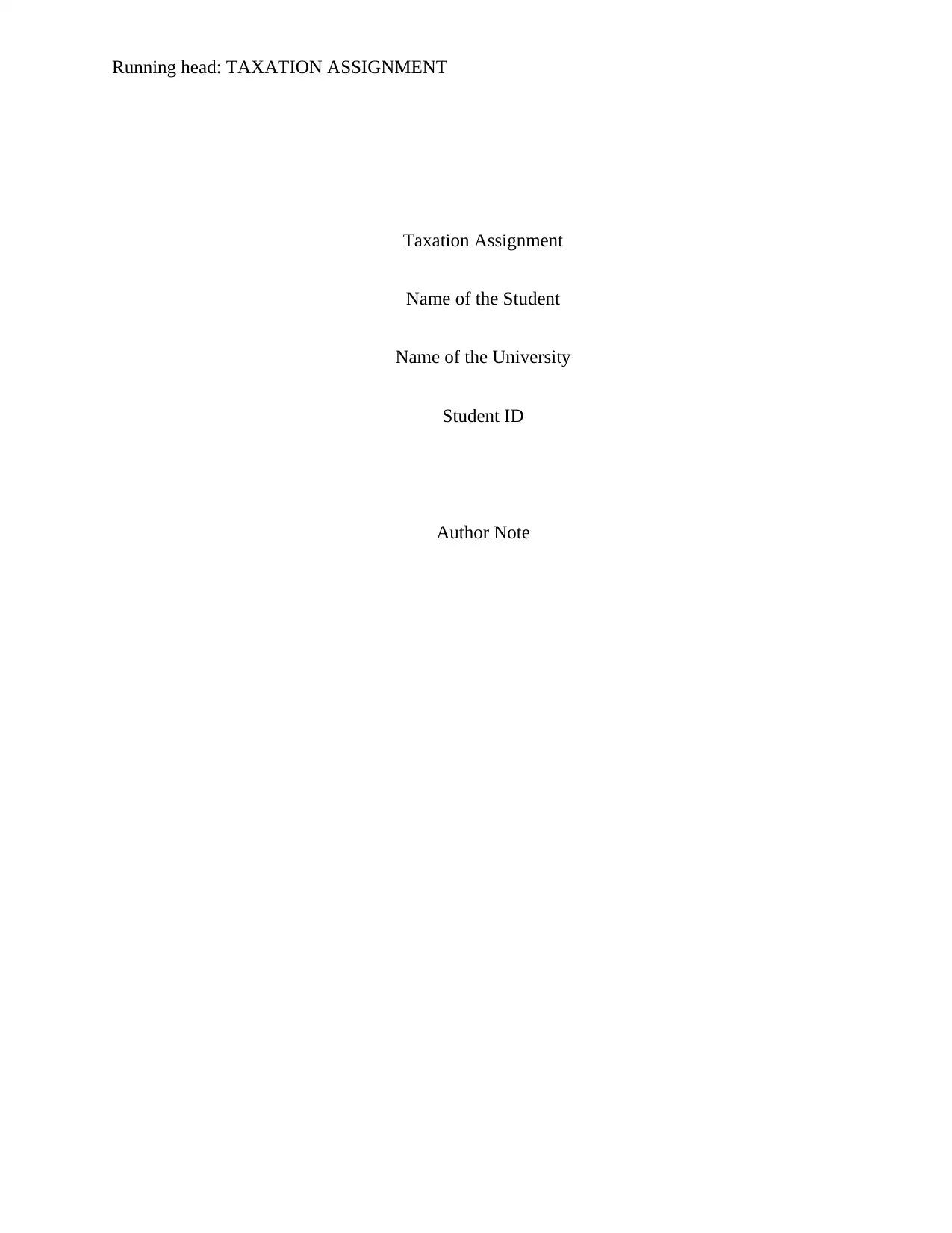
Running head: TAXATION ASSIGNMENT
Taxation Assignment
Name of the Student
Name of the University
Student ID
Author Note
Taxation Assignment
Name of the Student
Name of the University
Student ID
Author Note
Paraphrase This Document
Need a fresh take? Get an instant paraphrase of this document with our AI Paraphraser
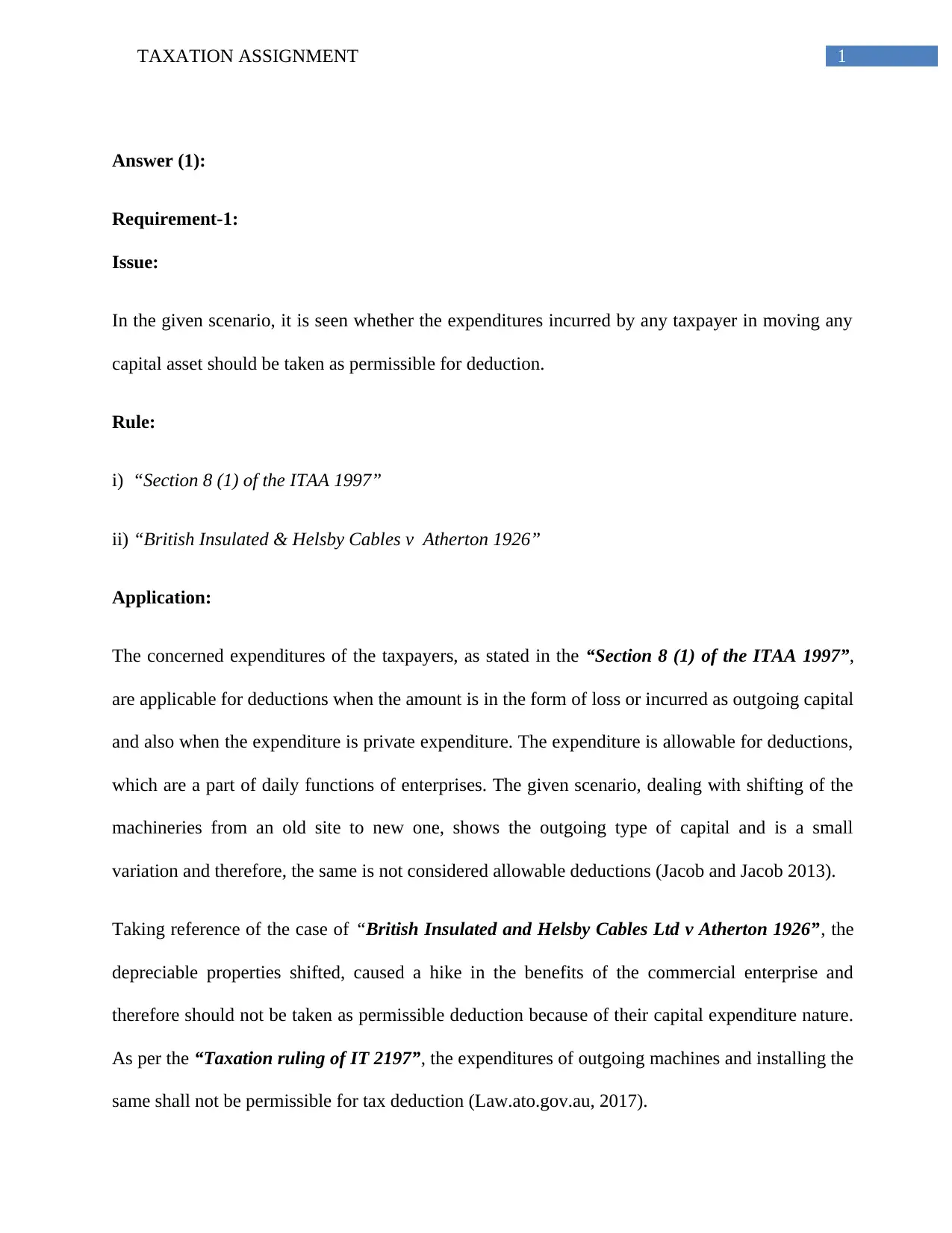
1TAXATION ASSIGNMENT
Answer (1):
Requirement-1:
Issue:
In the given scenario, it is seen whether the expenditures incurred by any taxpayer in moving any
capital asset should be taken as permissible for deduction.
Rule:
i) “Section 8 (1) of the ITAA 1997”
ii) “British Insulated & Helsby Cables v Atherton 1926”
Application:
The concerned expenditures of the taxpayers, as stated in the “Section 8 (1) of the ITAA 1997”,
are applicable for deductions when the amount is in the form of loss or incurred as outgoing capital
and also when the expenditure is private expenditure. The expenditure is allowable for deductions,
which are a part of daily functions of enterprises. The given scenario, dealing with shifting of the
machineries from an old site to new one, shows the outgoing type of capital and is a small
variation and therefore, the same is not considered allowable deductions (Jacob and Jacob 2013).
Taking reference of the case of “British Insulated and Helsby Cables Ltd v Atherton 1926”, the
depreciable properties shifted, caused a hike in the benefits of the commercial enterprise and
therefore should not be taken as permissible deduction because of their capital expenditure nature.
As per the “Taxation ruling of IT 2197”, the expenditures of outgoing machines and installing the
same shall not be permissible for tax deduction (Law.ato.gov.au, 2017).
Answer (1):
Requirement-1:
Issue:
In the given scenario, it is seen whether the expenditures incurred by any taxpayer in moving any
capital asset should be taken as permissible for deduction.
Rule:
i) “Section 8 (1) of the ITAA 1997”
ii) “British Insulated & Helsby Cables v Atherton 1926”
Application:
The concerned expenditures of the taxpayers, as stated in the “Section 8 (1) of the ITAA 1997”,
are applicable for deductions when the amount is in the form of loss or incurred as outgoing capital
and also when the expenditure is private expenditure. The expenditure is allowable for deductions,
which are a part of daily functions of enterprises. The given scenario, dealing with shifting of the
machineries from an old site to new one, shows the outgoing type of capital and is a small
variation and therefore, the same is not considered allowable deductions (Jacob and Jacob 2013).
Taking reference of the case of “British Insulated and Helsby Cables Ltd v Atherton 1926”, the
depreciable properties shifted, caused a hike in the benefits of the commercial enterprise and
therefore should not be taken as permissible deduction because of their capital expenditure nature.
As per the “Taxation ruling of IT 2197”, the expenditures of outgoing machines and installing the
same shall not be permissible for tax deduction (Law.ato.gov.au, 2017).
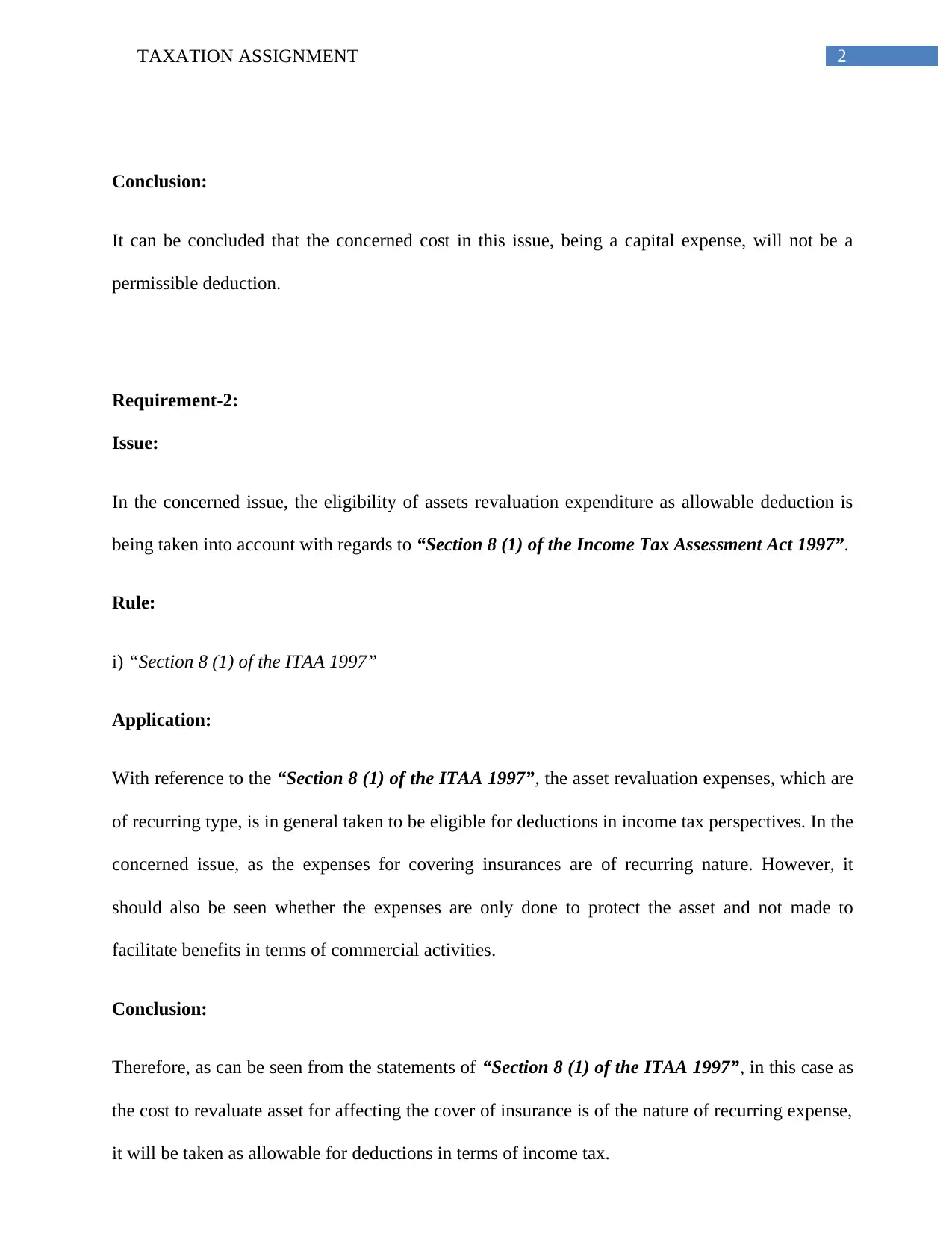
2TAXATION ASSIGNMENT
Conclusion:
It can be concluded that the concerned cost in this issue, being a capital expense, will not be a
permissible deduction.
Requirement-2:
Issue:
In the concerned issue, the eligibility of assets revaluation expenditure as allowable deduction is
being taken into account with regards to “Section 8 (1) of the Income Tax Assessment Act 1997”.
Rule:
i) “Section 8 (1) of the ITAA 1997”
Application:
With reference to the “Section 8 (1) of the ITAA 1997”, the asset revaluation expenses, which are
of recurring type, is in general taken to be eligible for deductions in income tax perspectives. In the
concerned issue, as the expenses for covering insurances are of recurring nature. However, it
should also be seen whether the expenses are only done to protect the asset and not made to
facilitate benefits in terms of commercial activities.
Conclusion:
Therefore, as can be seen from the statements of “Section 8 (1) of the ITAA 1997”, in this case as
the cost to revaluate asset for affecting the cover of insurance is of the nature of recurring expense,
it will be taken as allowable for deductions in terms of income tax.
Conclusion:
It can be concluded that the concerned cost in this issue, being a capital expense, will not be a
permissible deduction.
Requirement-2:
Issue:
In the concerned issue, the eligibility of assets revaluation expenditure as allowable deduction is
being taken into account with regards to “Section 8 (1) of the Income Tax Assessment Act 1997”.
Rule:
i) “Section 8 (1) of the ITAA 1997”
Application:
With reference to the “Section 8 (1) of the ITAA 1997”, the asset revaluation expenses, which are
of recurring type, is in general taken to be eligible for deductions in income tax perspectives. In the
concerned issue, as the expenses for covering insurances are of recurring nature. However, it
should also be seen whether the expenses are only done to protect the asset and not made to
facilitate benefits in terms of commercial activities.
Conclusion:
Therefore, as can be seen from the statements of “Section 8 (1) of the ITAA 1997”, in this case as
the cost to revaluate asset for affecting the cover of insurance is of the nature of recurring expense,
it will be taken as allowable for deductions in terms of income tax.
⊘ This is a preview!⊘
Do you want full access?
Subscribe today to unlock all pages.

Trusted by 1+ million students worldwide
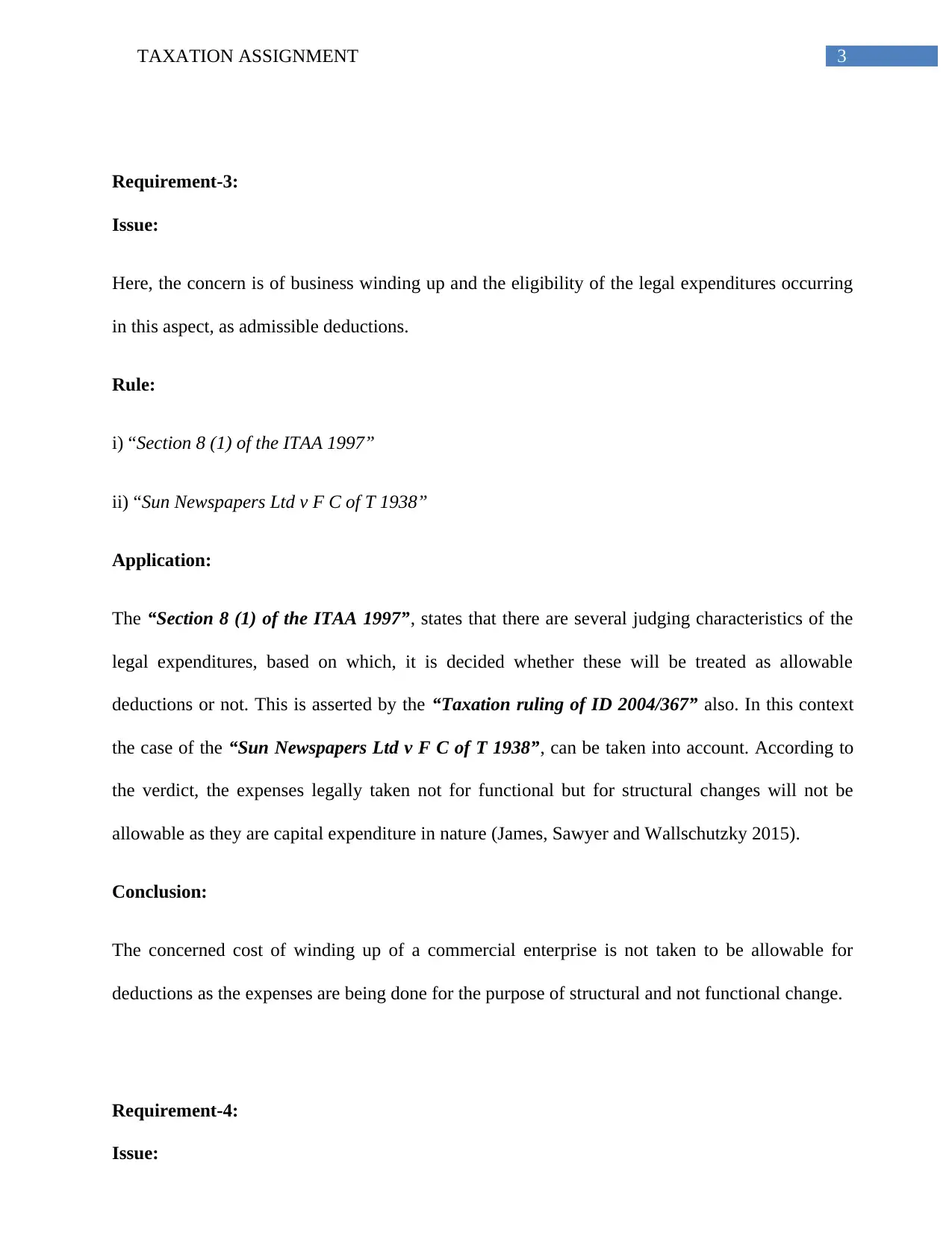
3TAXATION ASSIGNMENT
Requirement-3:
Issue:
Here, the concern is of business winding up and the eligibility of the legal expenditures occurring
in this aspect, as admissible deductions.
Rule:
i) “Section 8 (1) of the ITAA 1997”
ii) “Sun Newspapers Ltd v F C of T 1938”
Application:
The “Section 8 (1) of the ITAA 1997”, states that there are several judging characteristics of the
legal expenditures, based on which, it is decided whether these will be treated as allowable
deductions or not. This is asserted by the “Taxation ruling of ID 2004/367” also. In this context
the case of the “Sun Newspapers Ltd v F C of T 1938”, can be taken into account. According to
the verdict, the expenses legally taken not for functional but for structural changes will not be
allowable as they are capital expenditure in nature (James, Sawyer and Wallschutzky 2015).
Conclusion:
The concerned cost of winding up of a commercial enterprise is not taken to be allowable for
deductions as the expenses are being done for the purpose of structural and not functional change.
Requirement-4:
Issue:
Requirement-3:
Issue:
Here, the concern is of business winding up and the eligibility of the legal expenditures occurring
in this aspect, as admissible deductions.
Rule:
i) “Section 8 (1) of the ITAA 1997”
ii) “Sun Newspapers Ltd v F C of T 1938”
Application:
The “Section 8 (1) of the ITAA 1997”, states that there are several judging characteristics of the
legal expenditures, based on which, it is decided whether these will be treated as allowable
deductions or not. This is asserted by the “Taxation ruling of ID 2004/367” also. In this context
the case of the “Sun Newspapers Ltd v F C of T 1938”, can be taken into account. According to
the verdict, the expenses legally taken not for functional but for structural changes will not be
allowable as they are capital expenditure in nature (James, Sawyer and Wallschutzky 2015).
Conclusion:
The concerned cost of winding up of a commercial enterprise is not taken to be allowable for
deductions as the expenses are being done for the purpose of structural and not functional change.
Requirement-4:
Issue:
Paraphrase This Document
Need a fresh take? Get an instant paraphrase of this document with our AI Paraphraser
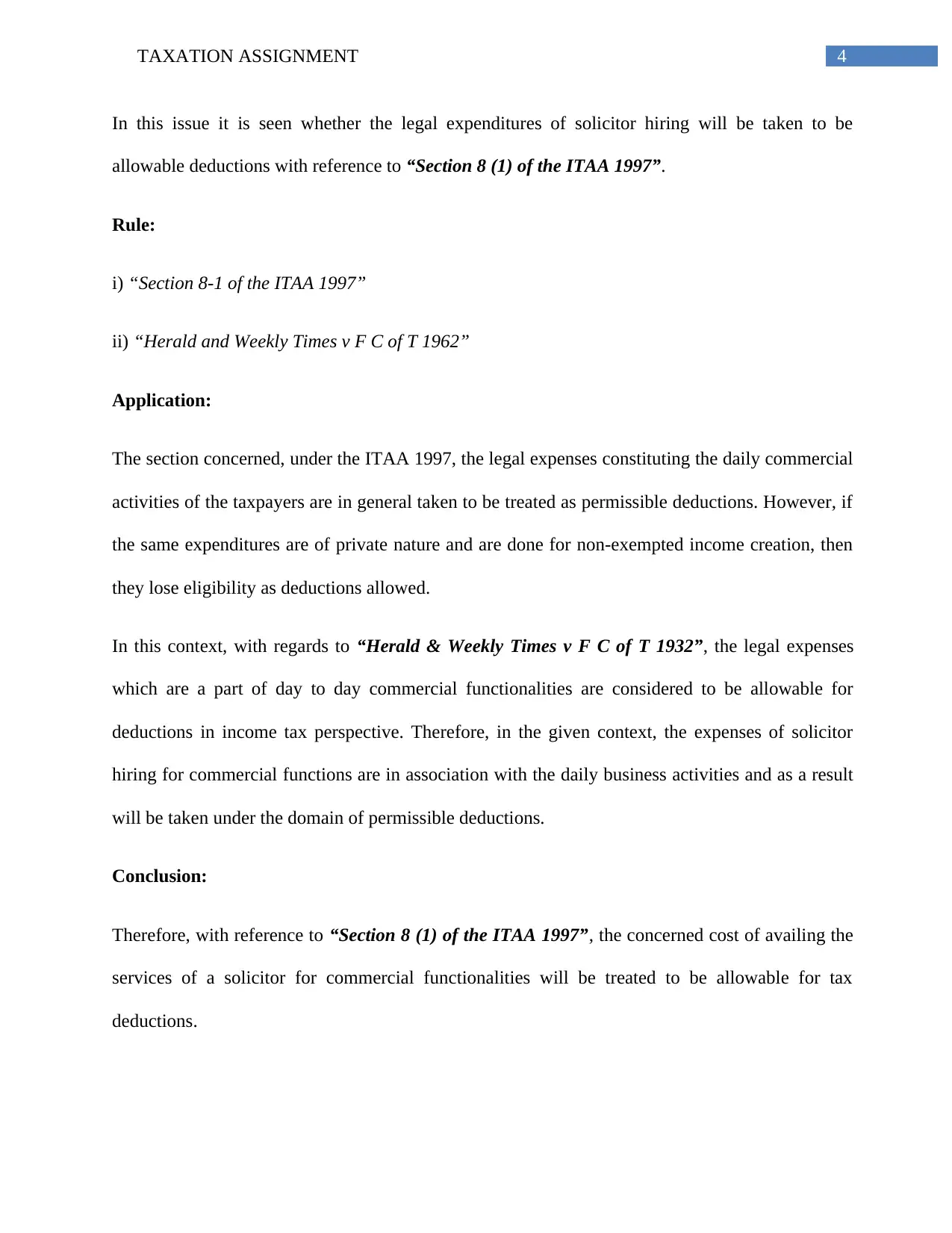
4TAXATION ASSIGNMENT
In this issue it is seen whether the legal expenditures of solicitor hiring will be taken to be
allowable deductions with reference to “Section 8 (1) of the ITAA 1997”.
Rule:
i) “Section 8-1 of the ITAA 1997”
ii) “Herald and Weekly Times v F C of T 1962”
Application:
The section concerned, under the ITAA 1997, the legal expenses constituting the daily commercial
activities of the taxpayers are in general taken to be treated as permissible deductions. However, if
the same expenditures are of private nature and are done for non-exempted income creation, then
they lose eligibility as deductions allowed.
In this context, with regards to “Herald & Weekly Times v F C of T 1932”, the legal expenses
which are a part of day to day commercial functionalities are considered to be allowable for
deductions in income tax perspective. Therefore, in the given context, the expenses of solicitor
hiring for commercial functions are in association with the daily business activities and as a result
will be taken under the domain of permissible deductions.
Conclusion:
Therefore, with reference to “Section 8 (1) of the ITAA 1997”, the concerned cost of availing the
services of a solicitor for commercial functionalities will be treated to be allowable for tax
deductions.
In this issue it is seen whether the legal expenditures of solicitor hiring will be taken to be
allowable deductions with reference to “Section 8 (1) of the ITAA 1997”.
Rule:
i) “Section 8-1 of the ITAA 1997”
ii) “Herald and Weekly Times v F C of T 1962”
Application:
The section concerned, under the ITAA 1997, the legal expenses constituting the daily commercial
activities of the taxpayers are in general taken to be treated as permissible deductions. However, if
the same expenditures are of private nature and are done for non-exempted income creation, then
they lose eligibility as deductions allowed.
In this context, with regards to “Herald & Weekly Times v F C of T 1932”, the legal expenses
which are a part of day to day commercial functionalities are considered to be allowable for
deductions in income tax perspective. Therefore, in the given context, the expenses of solicitor
hiring for commercial functions are in association with the daily business activities and as a result
will be taken under the domain of permissible deductions.
Conclusion:
Therefore, with reference to “Section 8 (1) of the ITAA 1997”, the concerned cost of availing the
services of a solicitor for commercial functionalities will be treated to be allowable for tax
deductions.
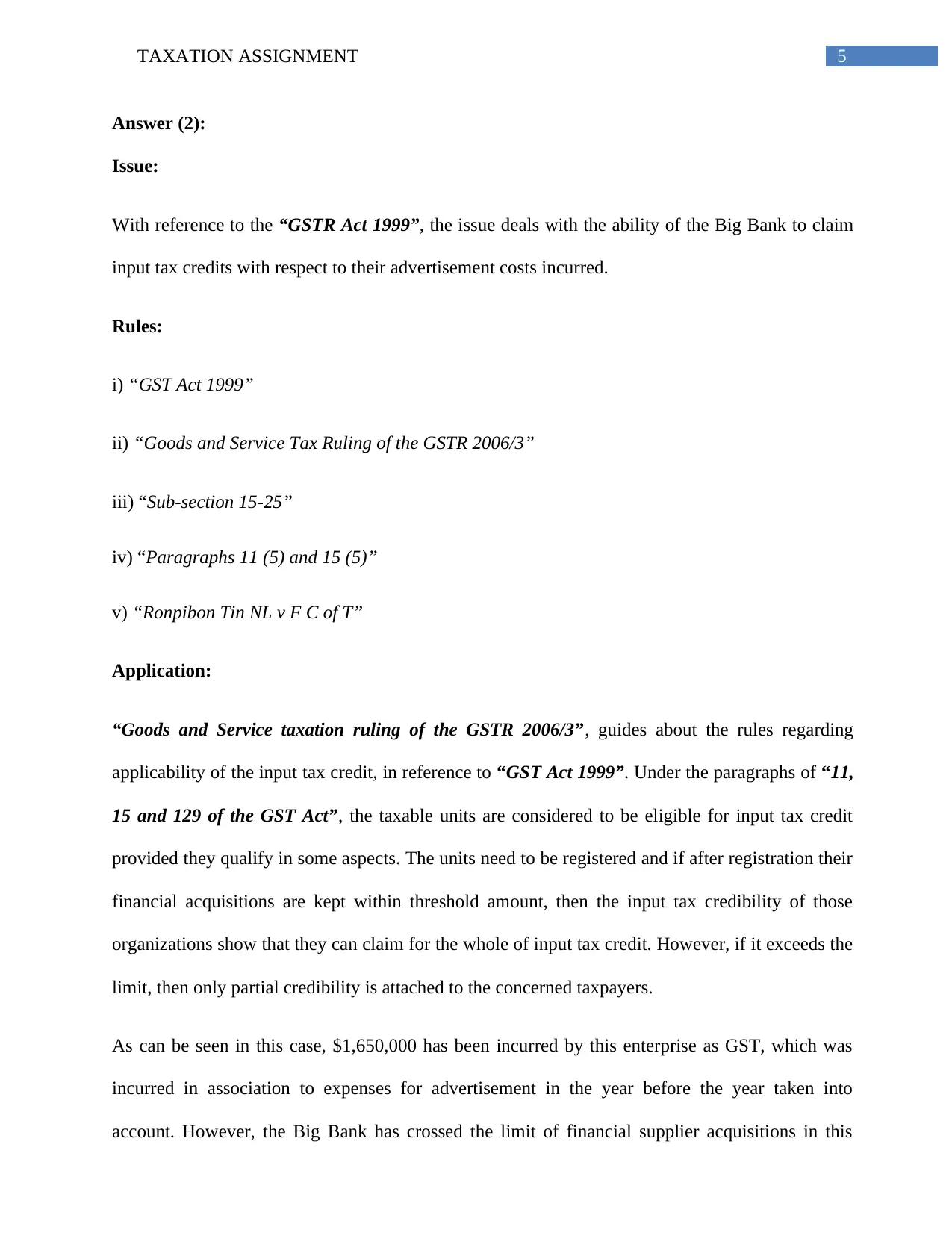
5TAXATION ASSIGNMENT
Answer (2):
Issue:
With reference to the “GSTR Act 1999”, the issue deals with the ability of the Big Bank to claim
input tax credits with respect to their advertisement costs incurred.
Rules:
i) “GST Act 1999”
ii) “Goods and Service Tax Ruling of the GSTR 2006/3”
iii) “Sub-section 15-25”
iv) “Paragraphs 11 (5) and 15 (5)”
v) “Ronpibon Tin NL v F C of T”
Application:
“Goods and Service taxation ruling of the GSTR 2006/3”, guides about the rules regarding
applicability of the input tax credit, in reference to “GST Act 1999”. Under the paragraphs of “11,
15 and 129 of the GST Act”, the taxable units are considered to be eligible for input tax credit
provided they qualify in some aspects. The units need to be registered and if after registration their
financial acquisitions are kept within threshold amount, then the input tax credibility of those
organizations show that they can claim for the whole of input tax credit. However, if it exceeds the
limit, then only partial credibility is attached to the concerned taxpayers.
As can be seen in this case, $1,650,000 has been incurred by this enterprise as GST, which was
incurred in association to expenses for advertisement in the year before the year taken into
account. However, the Big Bank has crossed the limit of financial supplier acquisitions in this
Answer (2):
Issue:
With reference to the “GSTR Act 1999”, the issue deals with the ability of the Big Bank to claim
input tax credits with respect to their advertisement costs incurred.
Rules:
i) “GST Act 1999”
ii) “Goods and Service Tax Ruling of the GSTR 2006/3”
iii) “Sub-section 15-25”
iv) “Paragraphs 11 (5) and 15 (5)”
v) “Ronpibon Tin NL v F C of T”
Application:
“Goods and Service taxation ruling of the GSTR 2006/3”, guides about the rules regarding
applicability of the input tax credit, in reference to “GST Act 1999”. Under the paragraphs of “11,
15 and 129 of the GST Act”, the taxable units are considered to be eligible for input tax credit
provided they qualify in some aspects. The units need to be registered and if after registration their
financial acquisitions are kept within threshold amount, then the input tax credibility of those
organizations show that they can claim for the whole of input tax credit. However, if it exceeds the
limit, then only partial credibility is attached to the concerned taxpayers.
As can be seen in this case, $1,650,000 has been incurred by this enterprise as GST, which was
incurred in association to expenses for advertisement in the year before the year taken into
account. However, the Big Bank has crossed the limit of financial supplier acquisitions in this
⊘ This is a preview!⊘
Do you want full access?
Subscribe today to unlock all pages.

Trusted by 1+ million students worldwide
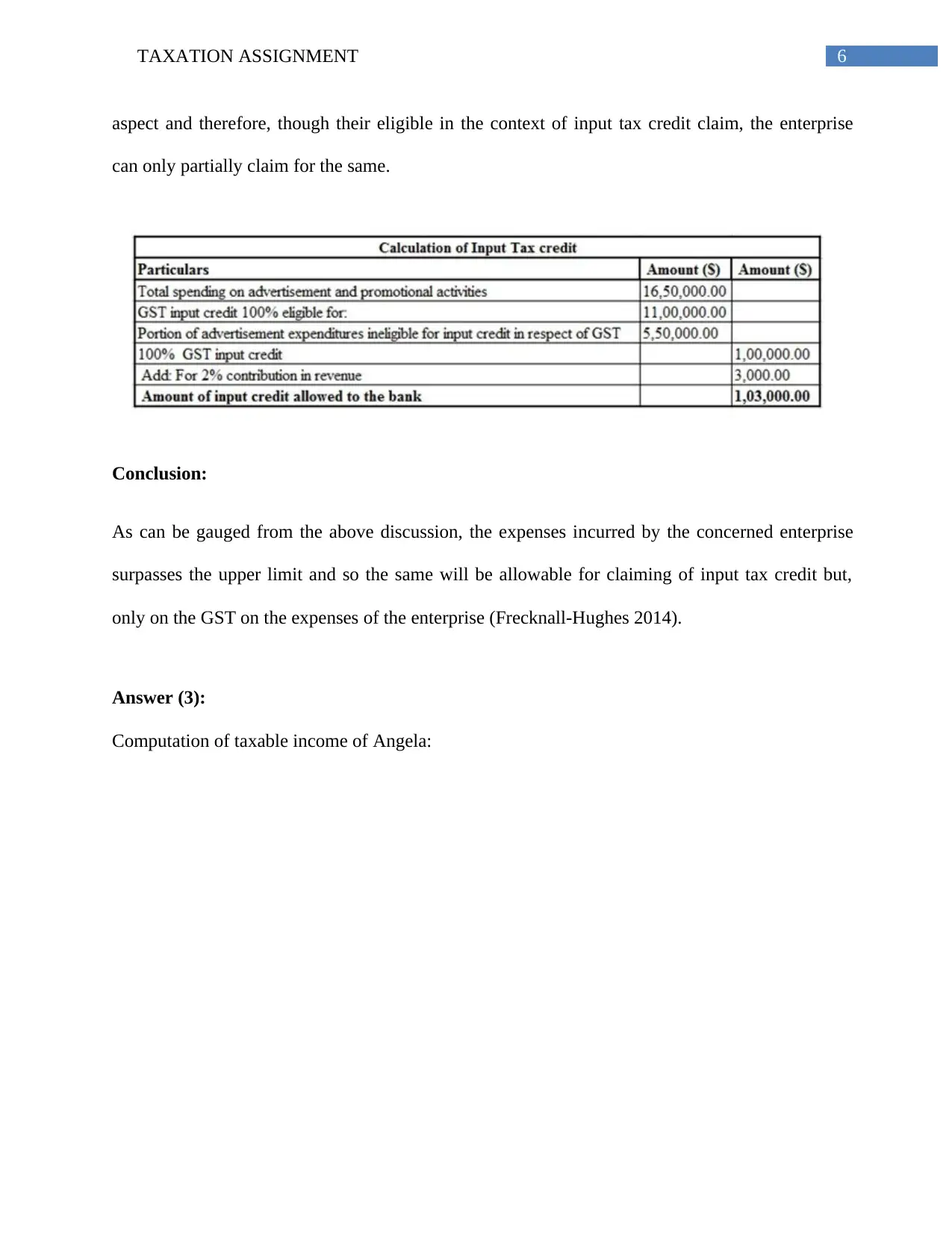
6TAXATION ASSIGNMENT
aspect and therefore, though their eligible in the context of input tax credit claim, the enterprise
can only partially claim for the same.
Conclusion:
As can be gauged from the above discussion, the expenses incurred by the concerned enterprise
surpasses the upper limit and so the same will be allowable for claiming of input tax credit but,
only on the GST on the expenses of the enterprise (Frecknall-Hughes 2014).
Answer (3):
Computation of taxable income of Angela:
aspect and therefore, though their eligible in the context of input tax credit claim, the enterprise
can only partially claim for the same.
Conclusion:
As can be gauged from the above discussion, the expenses incurred by the concerned enterprise
surpasses the upper limit and so the same will be allowable for claiming of input tax credit but,
only on the GST on the expenses of the enterprise (Frecknall-Hughes 2014).
Answer (3):
Computation of taxable income of Angela:
Paraphrase This Document
Need a fresh take? Get an instant paraphrase of this document with our AI Paraphraser
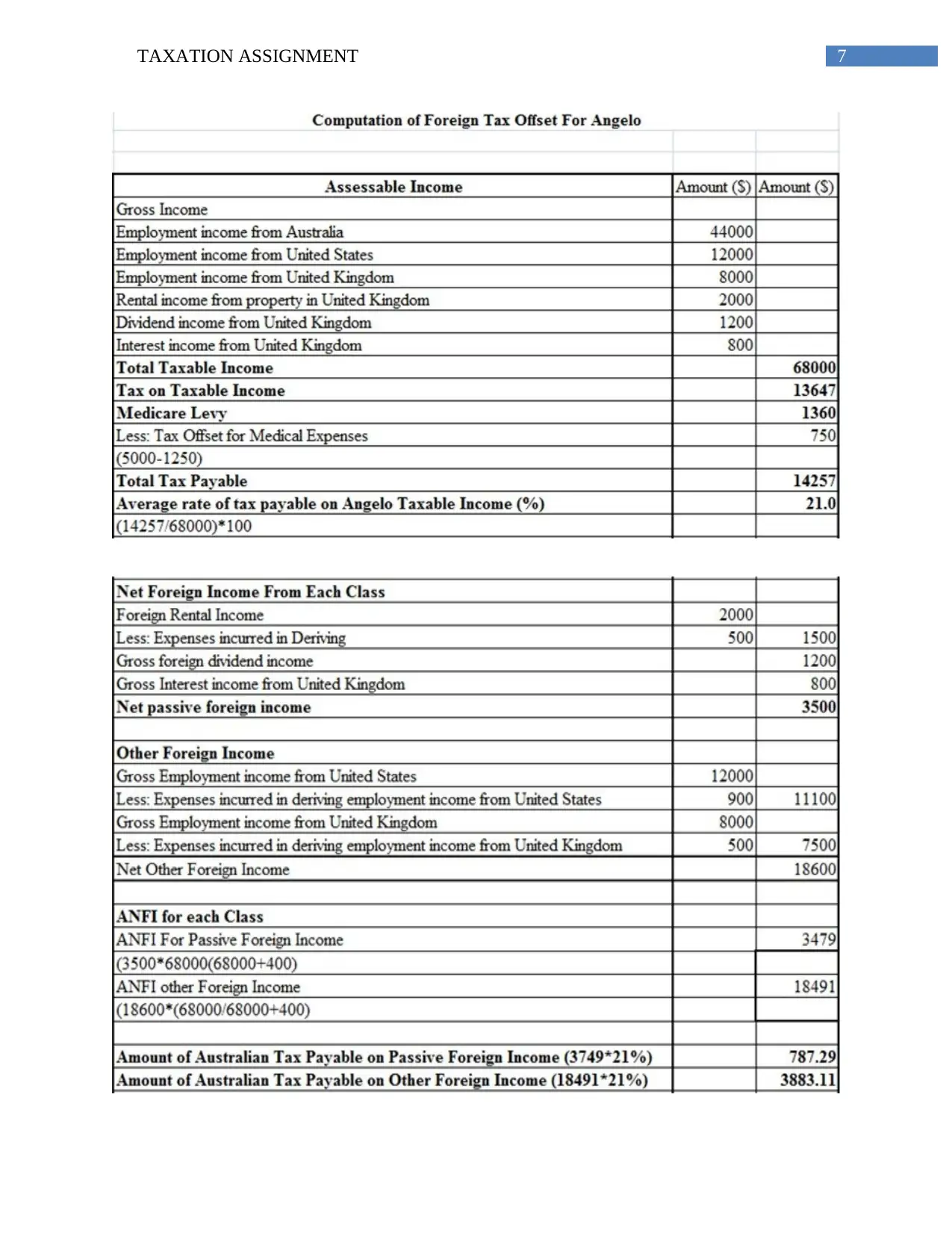
7TAXATION ASSIGNMENT
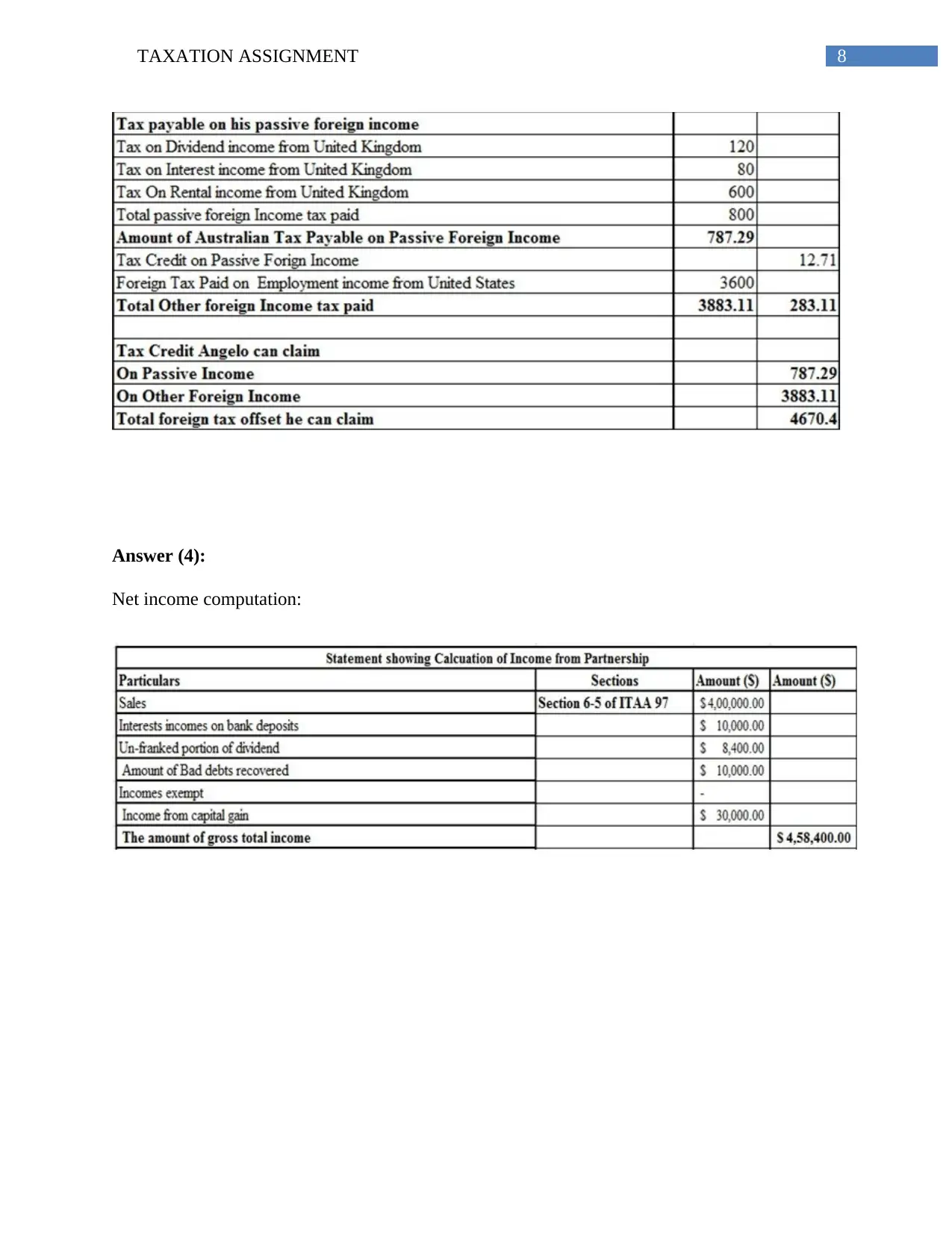
8TAXATION ASSIGNMENT
Answer (4):
Net income computation:
Answer (4):
Net income computation:
⊘ This is a preview!⊘
Do you want full access?
Subscribe today to unlock all pages.

Trusted by 1+ million students worldwide
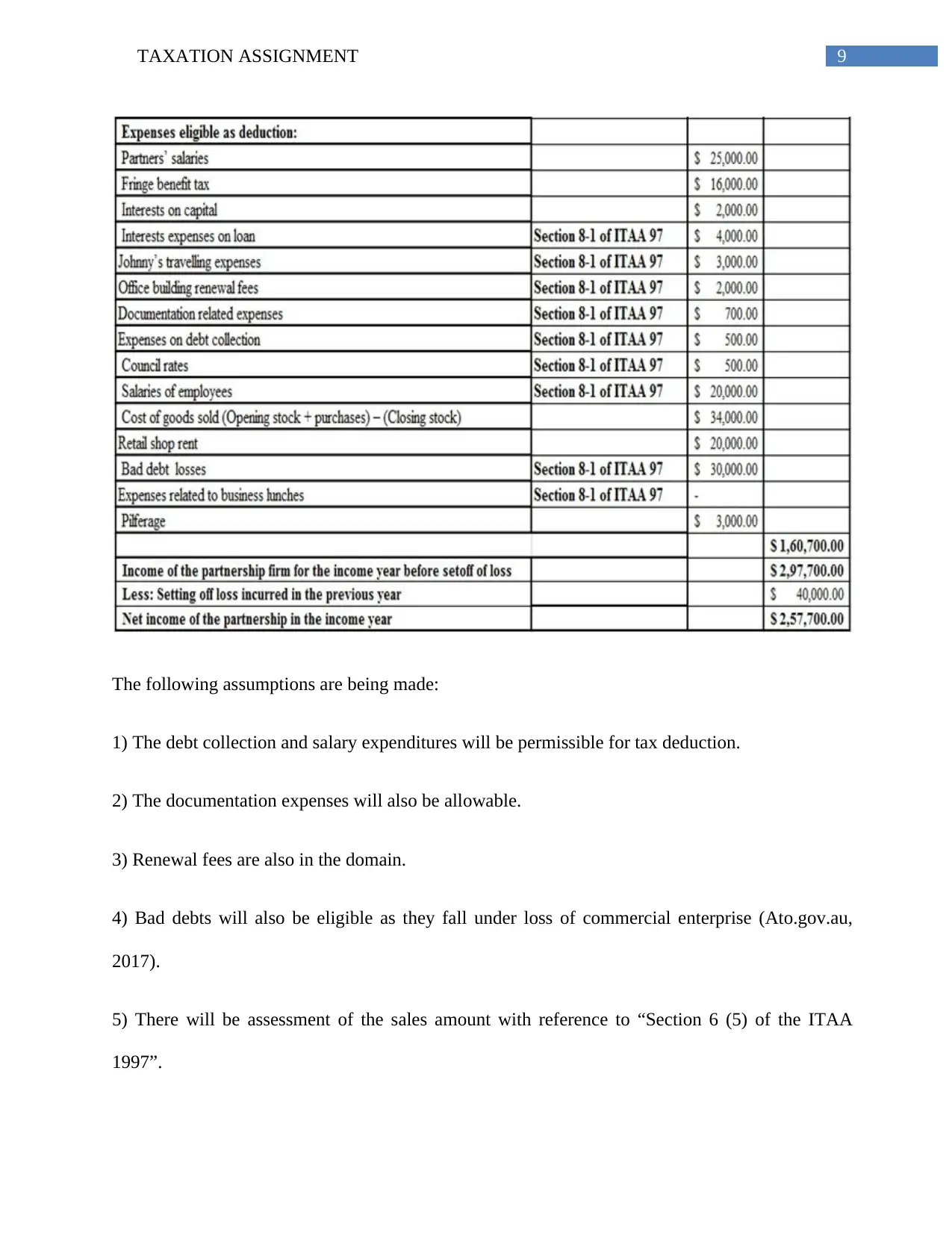
9TAXATION ASSIGNMENT
The following assumptions are being made:
1) The debt collection and salary expenditures will be permissible for tax deduction.
2) The documentation expenses will also be allowable.
3) Renewal fees are also in the domain.
4) Bad debts will also be eligible as they fall under loss of commercial enterprise (Ato.gov.au,
2017).
5) There will be assessment of the sales amount with reference to “Section 6 (5) of the ITAA
1997”.
The following assumptions are being made:
1) The debt collection and salary expenditures will be permissible for tax deduction.
2) The documentation expenses will also be allowable.
3) Renewal fees are also in the domain.
4) Bad debts will also be eligible as they fall under loss of commercial enterprise (Ato.gov.au,
2017).
5) There will be assessment of the sales amount with reference to “Section 6 (5) of the ITAA
1997”.
Paraphrase This Document
Need a fresh take? Get an instant paraphrase of this document with our AI Paraphraser
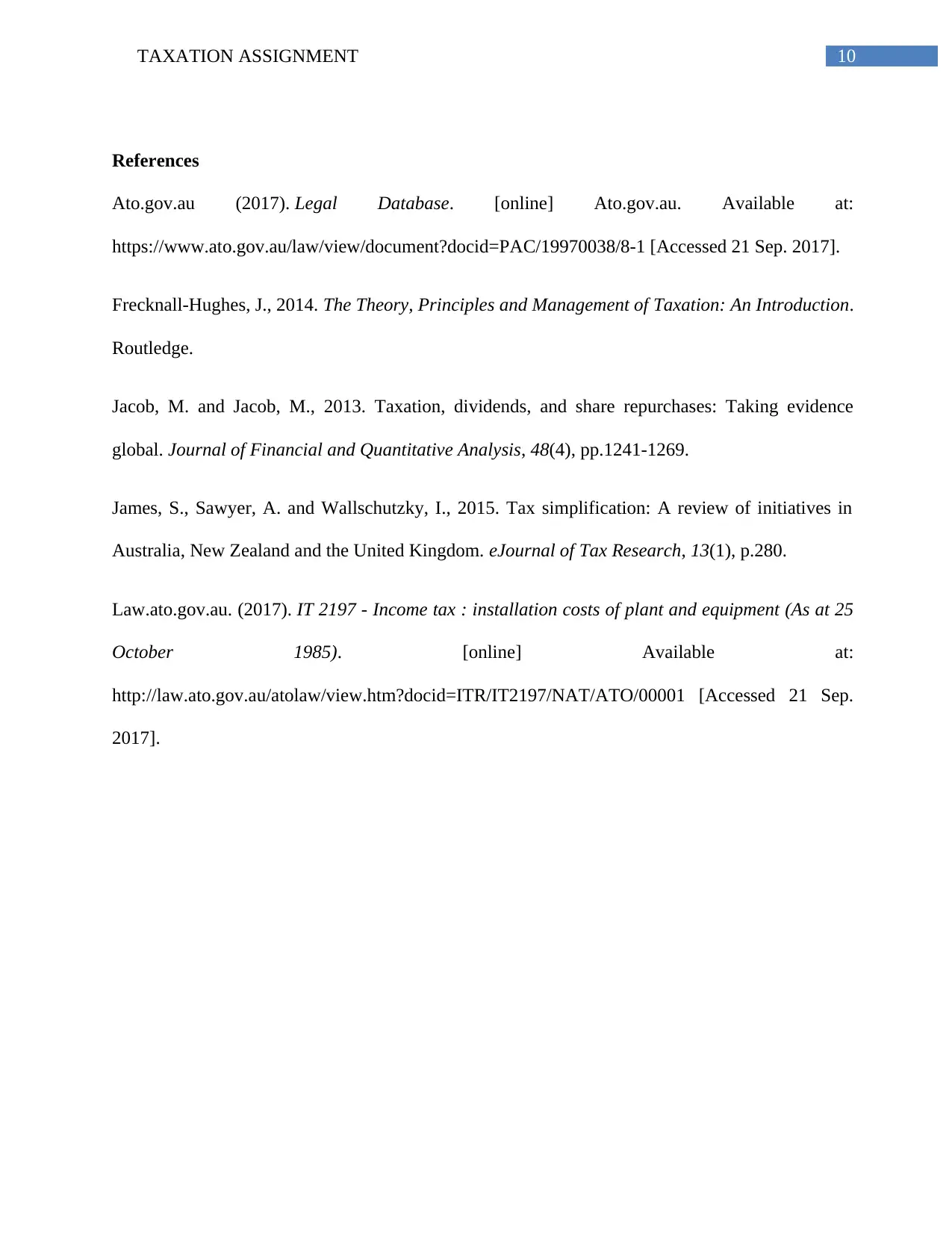
10TAXATION ASSIGNMENT
References
Ato.gov.au (2017). Legal Database. [online] Ato.gov.au. Available at:
https://www.ato.gov.au/law/view/document?docid=PAC/19970038/8-1 [Accessed 21 Sep. 2017].
Frecknall-Hughes, J., 2014. The Theory, Principles and Management of Taxation: An Introduction.
Routledge.
Jacob, M. and Jacob, M., 2013. Taxation, dividends, and share repurchases: Taking evidence
global. Journal of Financial and Quantitative Analysis, 48(4), pp.1241-1269.
James, S., Sawyer, A. and Wallschutzky, I., 2015. Tax simplification: A review of initiatives in
Australia, New Zealand and the United Kingdom. eJournal of Tax Research, 13(1), p.280.
Law.ato.gov.au. (2017). IT 2197 - Income tax : installation costs of plant and equipment (As at 25
October 1985). [online] Available at:
http://law.ato.gov.au/atolaw/view.htm?docid=ITR/IT2197/NAT/ATO/00001 [Accessed 21 Sep.
2017].
References
Ato.gov.au (2017). Legal Database. [online] Ato.gov.au. Available at:
https://www.ato.gov.au/law/view/document?docid=PAC/19970038/8-1 [Accessed 21 Sep. 2017].
Frecknall-Hughes, J., 2014. The Theory, Principles and Management of Taxation: An Introduction.
Routledge.
Jacob, M. and Jacob, M., 2013. Taxation, dividends, and share repurchases: Taking evidence
global. Journal of Financial and Quantitative Analysis, 48(4), pp.1241-1269.
James, S., Sawyer, A. and Wallschutzky, I., 2015. Tax simplification: A review of initiatives in
Australia, New Zealand and the United Kingdom. eJournal of Tax Research, 13(1), p.280.
Law.ato.gov.au. (2017). IT 2197 - Income tax : installation costs of plant and equipment (As at 25
October 1985). [online] Available at:
http://law.ato.gov.au/atolaw/view.htm?docid=ITR/IT2197/NAT/ATO/00001 [Accessed 21 Sep.
2017].
1 out of 11
Related Documents
Your All-in-One AI-Powered Toolkit for Academic Success.
+13062052269
info@desklib.com
Available 24*7 on WhatsApp / Email
![[object Object]](/_next/static/media/star-bottom.7253800d.svg)
Unlock your academic potential
Copyright © 2020–2025 A2Z Services. All Rights Reserved. Developed and managed by ZUCOL.





